Business Strategy and Stakeholder Analysis
VerifiedAdded on 2020/12/09
|15
|4349
|386
Report
AI Summary
This assignment requires a comprehensive analysis of Tesco's business strategy, focusing on key elements such as its business model, target market, competitive advantages, and ethical practices. Students must identify and evaluate the diverse stakeholders involved with Tesco, considering their interests, influence, and expectations. The analysis should also encompass Tesco's social impact, exploring both positive and negative consequences of its operations.
Contribute Materials
Your contribution can guide someone’s learning journey. Share your
documents today.
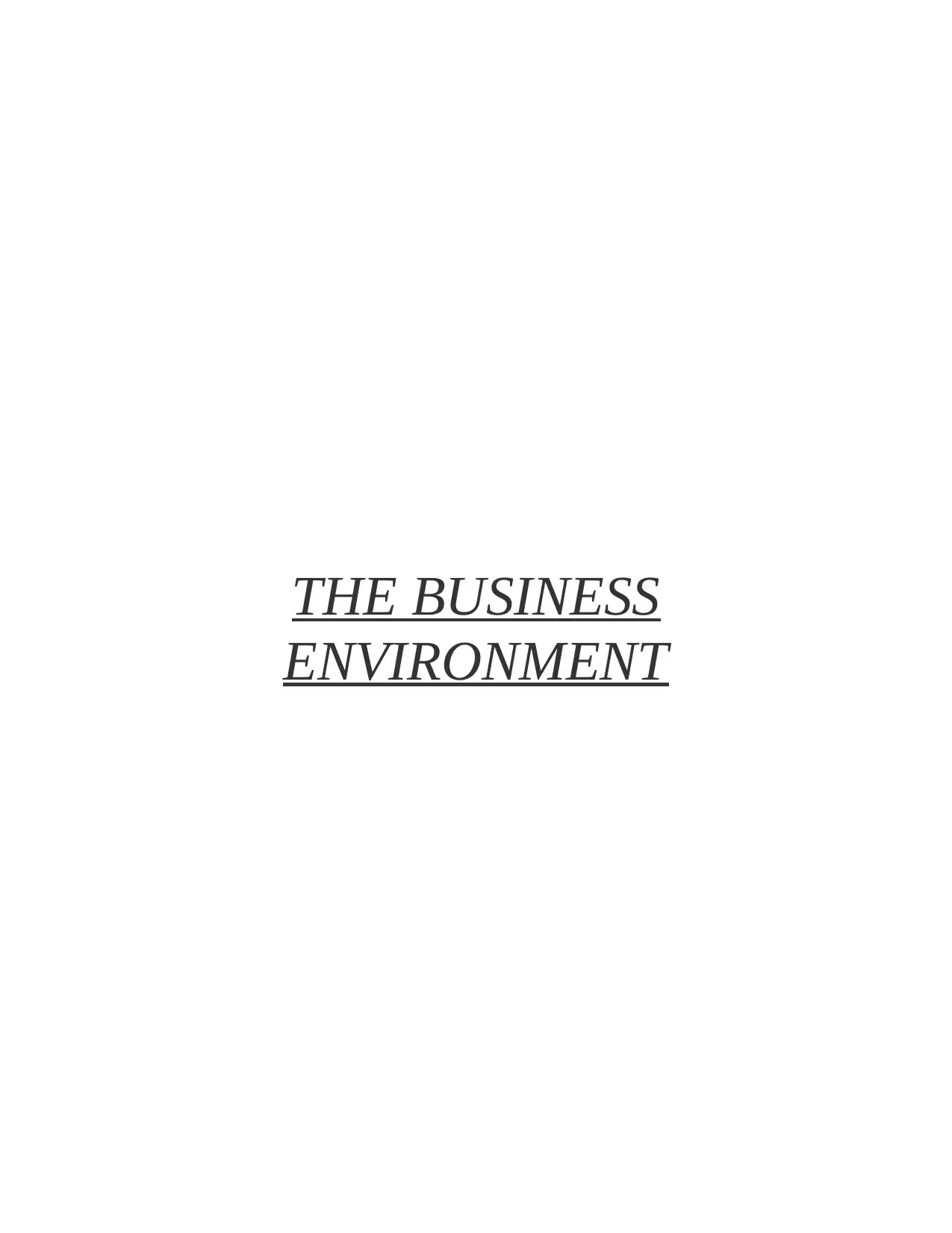
THE BUSINESS
ENVIRONMENT
ENVIRONMENT
Secure Best Marks with AI Grader
Need help grading? Try our AI Grader for instant feedback on your assignments.
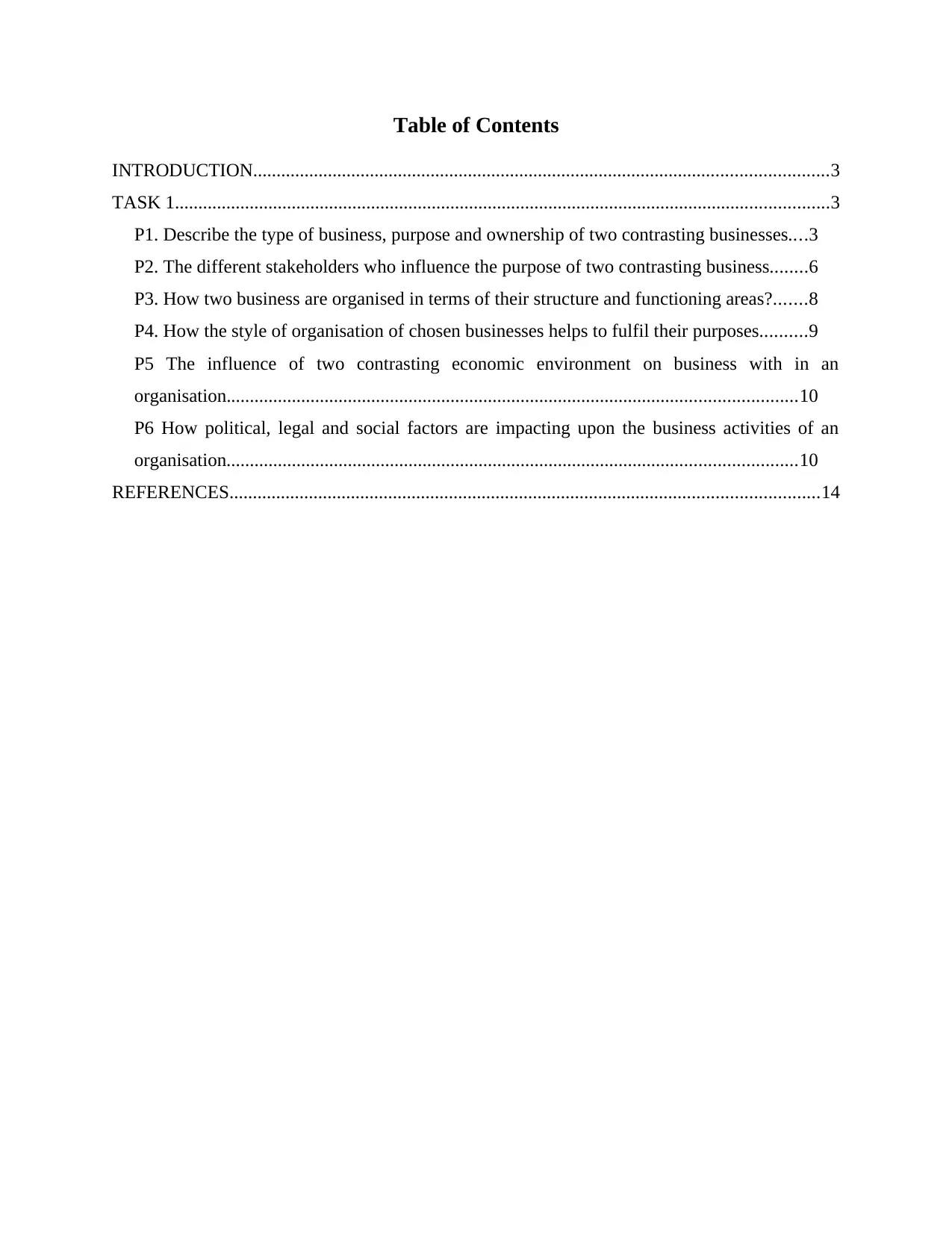
Table of Contents
INTRODUCTION...........................................................................................................................3
TASK 1............................................................................................................................................3
P1. Describe the type of business, purpose and ownership of two contrasting businesses....3
P2. The different stakeholders who influence the purpose of two contrasting business........6
P3. How two business are organised in terms of their structure and functioning areas?.......8
P4. How the style of organisation of chosen businesses helps to fulfil their purposes..........9
P5 The influence of two contrasting economic environment on business with in an
organisation..........................................................................................................................10
P6 How political, legal and social factors are impacting upon the business activities of an
organisation..........................................................................................................................10
REFERENCES..............................................................................................................................14
INTRODUCTION...........................................................................................................................3
TASK 1............................................................................................................................................3
P1. Describe the type of business, purpose and ownership of two contrasting businesses....3
P2. The different stakeholders who influence the purpose of two contrasting business........6
P3. How two business are organised in terms of their structure and functioning areas?.......8
P4. How the style of organisation of chosen businesses helps to fulfil their purposes..........9
P5 The influence of two contrasting economic environment on business with in an
organisation..........................................................................................................................10
P6 How political, legal and social factors are impacting upon the business activities of an
organisation..........................................................................................................................10
REFERENCES..............................................................................................................................14
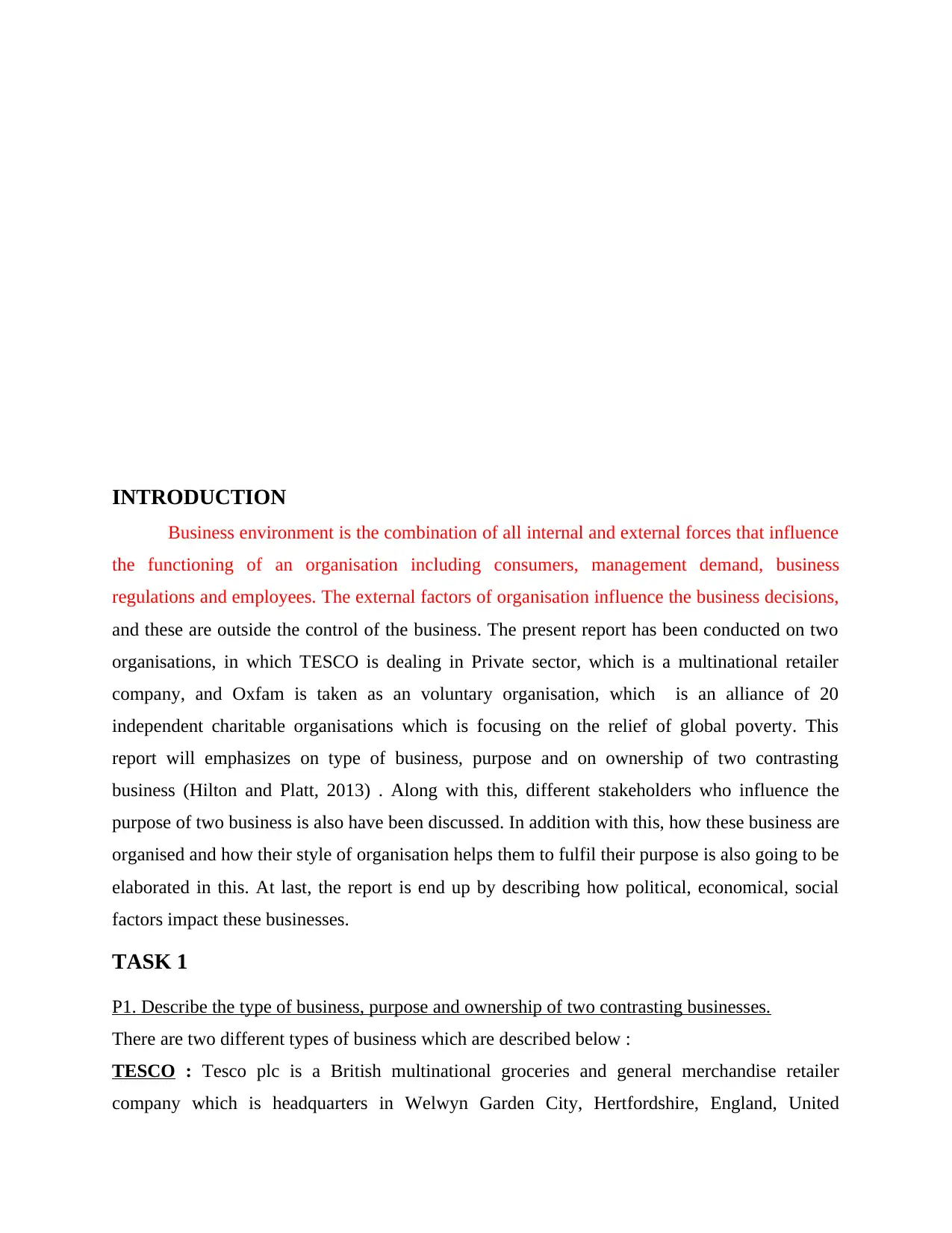
INTRODUCTION
Business environment is the combination of all internal and external forces that influence
the functioning of an organisation including consumers, management demand, business
regulations and employees. The external factors of organisation influence the business decisions,
and these are outside the control of the business. The present report has been conducted on two
organisations, in which TESCO is dealing in Private sector, which is a multinational retailer
company, and Oxfam is taken as an voluntary organisation, which is an alliance of 20
independent charitable organisations which is focusing on the relief of global poverty. This
report will emphasizes on type of business, purpose and on ownership of two contrasting
business (Hilton and Platt, 2013) . Along with this, different stakeholders who influence the
purpose of two business is also have been discussed. In addition with this, how these business are
organised and how their style of organisation helps them to fulfil their purpose is also going to be
elaborated in this. At last, the report is end up by describing how political, economical, social
factors impact these businesses.
TASK 1
P1. Describe the type of business, purpose and ownership of two contrasting businesses.
There are two different types of business which are described below :
TESCO : Tesco plc is a British multinational groceries and general merchandise retailer
company which is headquarters in Welwyn Garden City, Hertfordshire, England, United
Business environment is the combination of all internal and external forces that influence
the functioning of an organisation including consumers, management demand, business
regulations and employees. The external factors of organisation influence the business decisions,
and these are outside the control of the business. The present report has been conducted on two
organisations, in which TESCO is dealing in Private sector, which is a multinational retailer
company, and Oxfam is taken as an voluntary organisation, which is an alliance of 20
independent charitable organisations which is focusing on the relief of global poverty. This
report will emphasizes on type of business, purpose and on ownership of two contrasting
business (Hilton and Platt, 2013) . Along with this, different stakeholders who influence the
purpose of two business is also have been discussed. In addition with this, how these business are
organised and how their style of organisation helps them to fulfil their purpose is also going to be
elaborated in this. At last, the report is end up by describing how political, economical, social
factors impact these businesses.
TASK 1
P1. Describe the type of business, purpose and ownership of two contrasting businesses.
There are two different types of business which are described below :
TESCO : Tesco plc is a British multinational groceries and general merchandise retailer
company which is headquarters in Welwyn Garden City, Hertfordshire, England, United
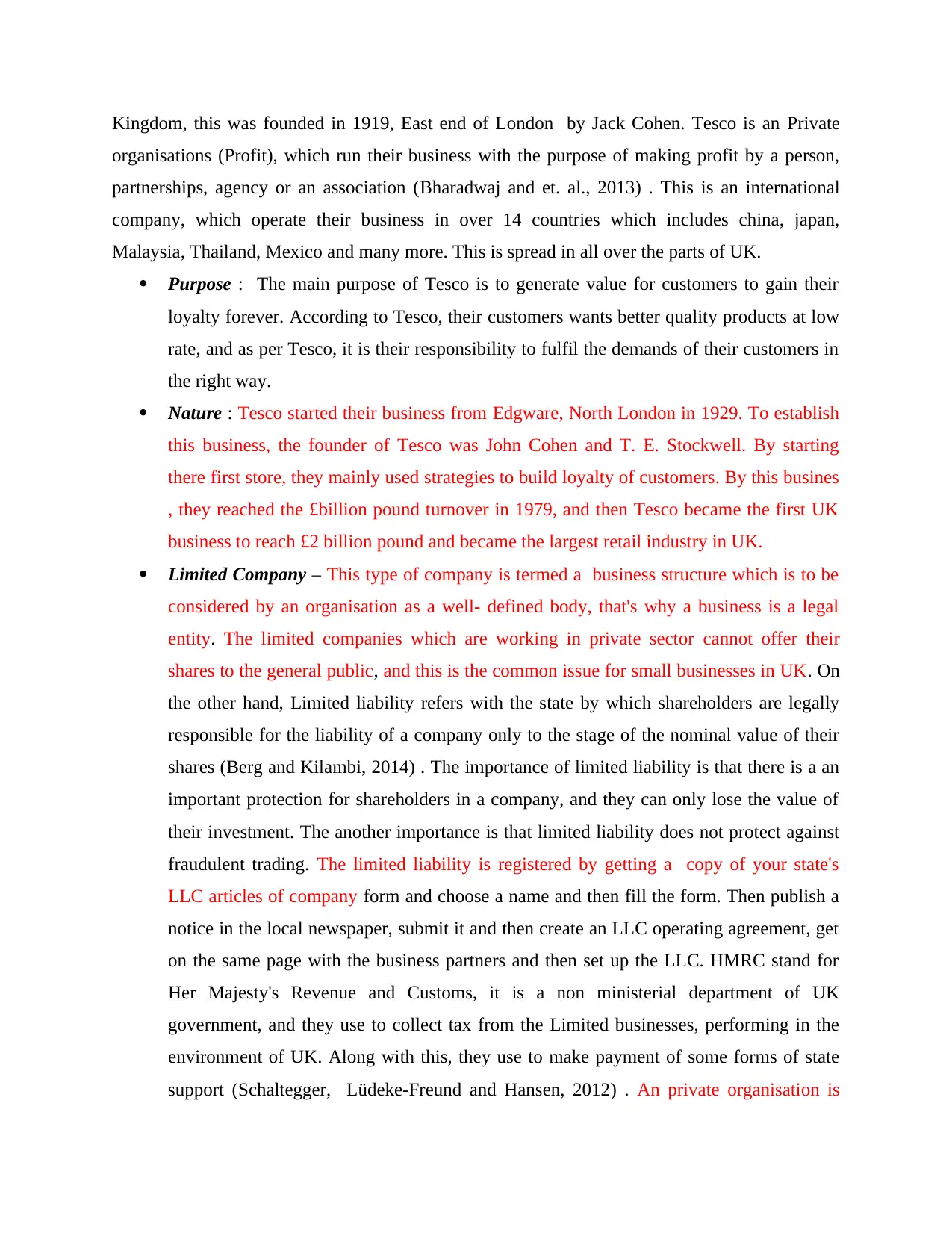
Kingdom, this was founded in 1919, East end of London by Jack Cohen. Tesco is an Private
organisations (Profit), which run their business with the purpose of making profit by a person,
partnerships, agency or an association (Bharadwaj and et. al., 2013) . This is an international
company, which operate their business in over 14 countries which includes china, japan,
Malaysia, Thailand, Mexico and many more. This is spread in all over the parts of UK.
Purpose : The main purpose of Tesco is to generate value for customers to gain their
loyalty forever. According to Tesco, their customers wants better quality products at low
rate, and as per Tesco, it is their responsibility to fulfil the demands of their customers in
the right way.
Nature : Tesco started their business from Edgware, North London in 1929. To establish
this business, the founder of Tesco was John Cohen and T. E. Stockwell. By starting
there first store, they mainly used strategies to build loyalty of customers. By this busines
, they reached the £billion pound turnover in 1979, and then Tesco became the first UK
business to reach £2 billion pound and became the largest retail industry in UK.
Limited Company – This type of company is termed a business structure which is to be
considered by an organisation as a well- defined body, that's why a business is a legal
entity. The limited companies which are working in private sector cannot offer their
shares to the general public, and this is the common issue for small businesses in UK. On
the other hand, Limited liability refers with the state by which shareholders are legally
responsible for the liability of a company only to the stage of the nominal value of their
shares (Berg and Kilambi, 2014) . The importance of limited liability is that there is a an
important protection for shareholders in a company, and they can only lose the value of
their investment. The another importance is that limited liability does not protect against
fraudulent trading. The limited liability is registered by getting a copy of your state's
LLC articles of company form and choose a name and then fill the form. Then publish a
notice in the local newspaper, submit it and then create an LLC operating agreement, get
on the same page with the business partners and then set up the LLC. HMRC stand for
Her Majesty's Revenue and Customs, it is a non ministerial department of UK
government, and they use to collect tax from the Limited businesses, performing in the
environment of UK. Along with this, they use to make payment of some forms of state
support (Schaltegger, Lüdeke-Freund and Hansen, 2012) . An private organisation is
organisations (Profit), which run their business with the purpose of making profit by a person,
partnerships, agency or an association (Bharadwaj and et. al., 2013) . This is an international
company, which operate their business in over 14 countries which includes china, japan,
Malaysia, Thailand, Mexico and many more. This is spread in all over the parts of UK.
Purpose : The main purpose of Tesco is to generate value for customers to gain their
loyalty forever. According to Tesco, their customers wants better quality products at low
rate, and as per Tesco, it is their responsibility to fulfil the demands of their customers in
the right way.
Nature : Tesco started their business from Edgware, North London in 1929. To establish
this business, the founder of Tesco was John Cohen and T. E. Stockwell. By starting
there first store, they mainly used strategies to build loyalty of customers. By this busines
, they reached the £billion pound turnover in 1979, and then Tesco became the first UK
business to reach £2 billion pound and became the largest retail industry in UK.
Limited Company – This type of company is termed a business structure which is to be
considered by an organisation as a well- defined body, that's why a business is a legal
entity. The limited companies which are working in private sector cannot offer their
shares to the general public, and this is the common issue for small businesses in UK. On
the other hand, Limited liability refers with the state by which shareholders are legally
responsible for the liability of a company only to the stage of the nominal value of their
shares (Berg and Kilambi, 2014) . The importance of limited liability is that there is a an
important protection for shareholders in a company, and they can only lose the value of
their investment. The another importance is that limited liability does not protect against
fraudulent trading. The limited liability is registered by getting a copy of your state's
LLC articles of company form and choose a name and then fill the form. Then publish a
notice in the local newspaper, submit it and then create an LLC operating agreement, get
on the same page with the business partners and then set up the LLC. HMRC stand for
Her Majesty's Revenue and Customs, it is a non ministerial department of UK
government, and they use to collect tax from the Limited businesses, performing in the
environment of UK. Along with this, they use to make payment of some forms of state
support (Schaltegger, Lüdeke-Freund and Hansen, 2012) . An private organisation is
Secure Best Marks with AI Grader
Need help grading? Try our AI Grader for instant feedback on your assignments.
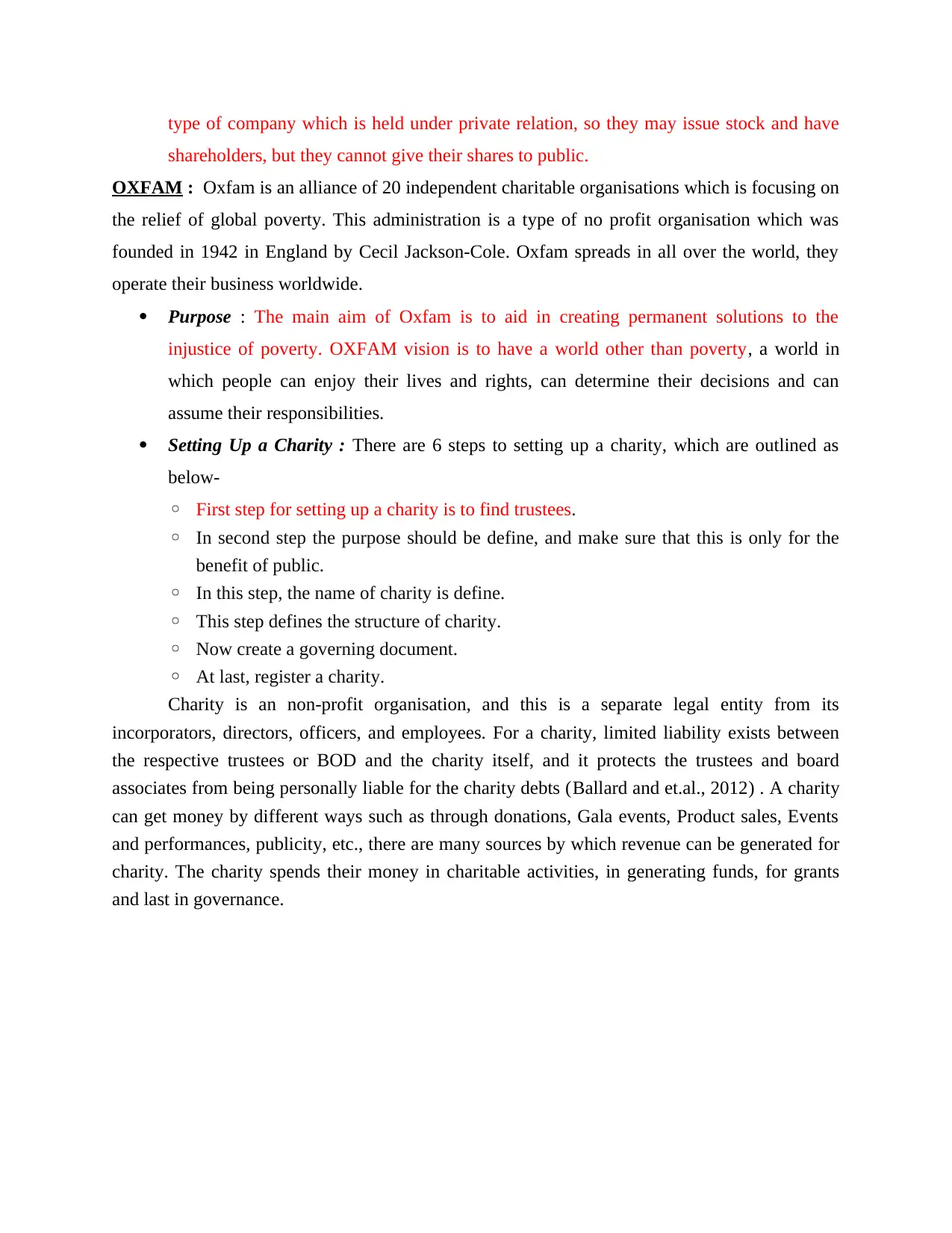
type of company which is held under private relation, so they may issue stock and have
shareholders, but they cannot give their shares to public.
OXFAM : Oxfam is an alliance of 20 independent charitable organisations which is focusing on
the relief of global poverty. This administration is a type of no profit organisation which was
founded in 1942 in England by Cecil Jackson-Cole. Oxfam spreads in all over the world, they
operate their business worldwide.
Purpose : The main aim of Oxfam is to aid in creating permanent solutions to the
injustice of poverty. OXFAM vision is to have a world other than poverty, a world in
which people can enjoy their lives and rights, can determine their decisions and can
assume their responsibilities.
Setting Up a Charity : There are 6 steps to setting up a charity, which are outlined as
below-
◦ First step for setting up a charity is to find trustees.
◦ In second step the purpose should be define, and make sure that this is only for the
benefit of public.
◦ In this step, the name of charity is define.
◦ This step defines the structure of charity.
◦ Now create a governing document.
◦ At last, register a charity.
Charity is an non-profit organisation, and this is a separate legal entity from its
incorporators, directors, officers, and employees. For a charity, limited liability exists between
the respective trustees or BOD and the charity itself, and it protects the trustees and board
associates from being personally liable for the charity debts (Ballard and et.al., 2012) . A charity
can get money by different ways such as through donations, Gala events, Product sales, Events
and performances, publicity, etc., there are many sources by which revenue can be generated for
charity. The charity spends their money in charitable activities, in generating funds, for grants
and last in governance.
shareholders, but they cannot give their shares to public.
OXFAM : Oxfam is an alliance of 20 independent charitable organisations which is focusing on
the relief of global poverty. This administration is a type of no profit organisation which was
founded in 1942 in England by Cecil Jackson-Cole. Oxfam spreads in all over the world, they
operate their business worldwide.
Purpose : The main aim of Oxfam is to aid in creating permanent solutions to the
injustice of poverty. OXFAM vision is to have a world other than poverty, a world in
which people can enjoy their lives and rights, can determine their decisions and can
assume their responsibilities.
Setting Up a Charity : There are 6 steps to setting up a charity, which are outlined as
below-
◦ First step for setting up a charity is to find trustees.
◦ In second step the purpose should be define, and make sure that this is only for the
benefit of public.
◦ In this step, the name of charity is define.
◦ This step defines the structure of charity.
◦ Now create a governing document.
◦ At last, register a charity.
Charity is an non-profit organisation, and this is a separate legal entity from its
incorporators, directors, officers, and employees. For a charity, limited liability exists between
the respective trustees or BOD and the charity itself, and it protects the trustees and board
associates from being personally liable for the charity debts (Ballard and et.al., 2012) . A charity
can get money by different ways such as through donations, Gala events, Product sales, Events
and performances, publicity, etc., there are many sources by which revenue can be generated for
charity. The charity spends their money in charitable activities, in generating funds, for grants
and last in governance.
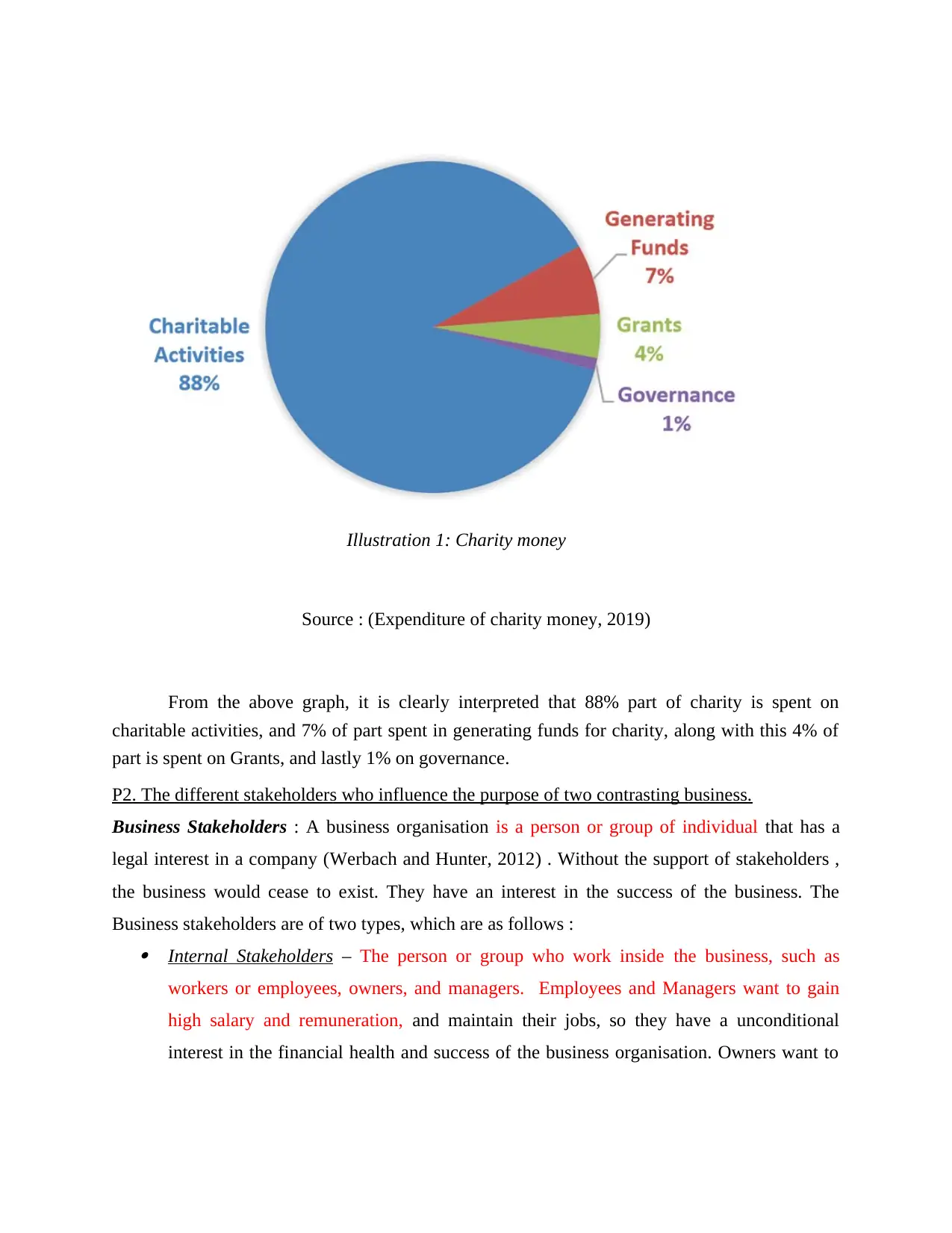
Source : (Expenditure of charity money, 2019)
From the above graph, it is clearly interpreted that 88% part of charity is spent on
charitable activities, and 7% of part spent in generating funds for charity, along with this 4% of
part is spent on Grants, and lastly 1% on governance.
P2. The different stakeholders who influence the purpose of two contrasting business.
Business Stakeholders : A business organisation is a person or group of individual that has a
legal interest in a company (Werbach and Hunter, 2012) . Without the support of stakeholders ,
the business would cease to exist. They have an interest in the success of the business. The
Business stakeholders are of two types, which are as follows : Internal Stakeholders – The person or group who work inside the business, such as
workers or employees, owners, and managers. Employees and Managers want to gain
high salary and remuneration, and maintain their jobs, so they have a unconditional
interest in the financial health and success of the business organisation. Owners want to
Illustration 1: Charity money
From the above graph, it is clearly interpreted that 88% part of charity is spent on
charitable activities, and 7% of part spent in generating funds for charity, along with this 4% of
part is spent on Grants, and lastly 1% on governance.
P2. The different stakeholders who influence the purpose of two contrasting business.
Business Stakeholders : A business organisation is a person or group of individual that has a
legal interest in a company (Werbach and Hunter, 2012) . Without the support of stakeholders ,
the business would cease to exist. They have an interest in the success of the business. The
Business stakeholders are of two types, which are as follows : Internal Stakeholders – The person or group who work inside the business, such as
workers or employees, owners, and managers. Employees and Managers want to gain
high salary and remuneration, and maintain their jobs, so they have a unconditional
interest in the financial health and success of the business organisation. Owners want to
Illustration 1: Charity money
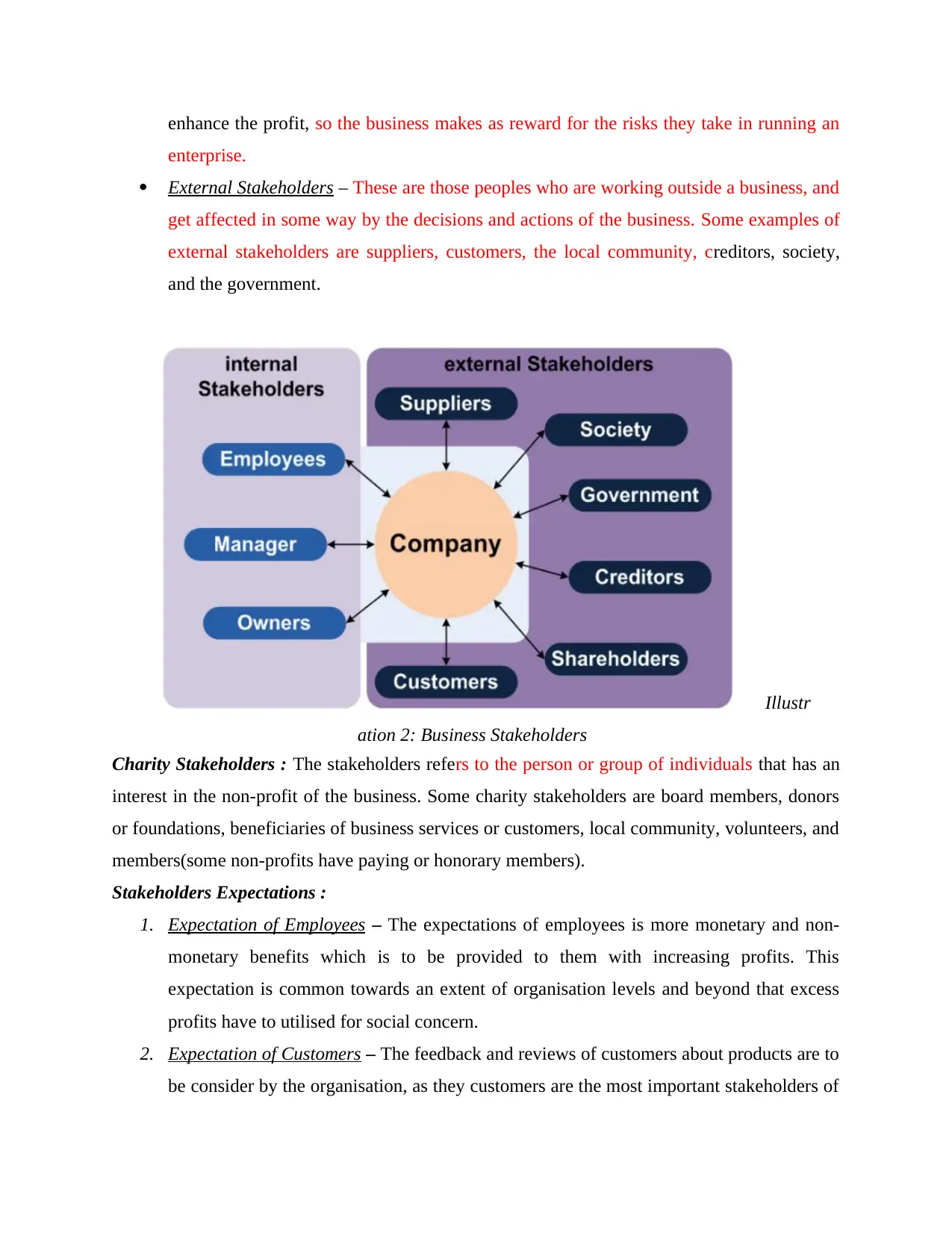
enhance the profit, so the business makes as reward for the risks they take in running an
enterprise.
External Stakeholders – These are those peoples who are working outside a business, and
get affected in some way by the decisions and actions of the business. Some examples of
external stakeholders are suppliers, customers, the local community, creditors, society,
and the government.
Charity Stakeholders : The stakeholders refers to the person or group of individuals that has an
interest in the non-profit of the business. Some charity stakeholders are board members, donors
or foundations, beneficiaries of business services or customers, local community, volunteers, and
members(some non-profits have paying or honorary members).
Stakeholders Expectations :
1. Expectation of Employees – The expectations of employees is more monetary and non-
monetary benefits which is to be provided to them with increasing profits. This
expectation is common towards an extent of organisation levels and beyond that excess
profits have to utilised for social concern.
2. Expectation of Customers – The feedback and reviews of customers about products are to
be consider by the organisation, as they customers are the most important stakeholders of
Illustr
ation 2: Business Stakeholders
enterprise.
External Stakeholders – These are those peoples who are working outside a business, and
get affected in some way by the decisions and actions of the business. Some examples of
external stakeholders are suppliers, customers, the local community, creditors, society,
and the government.
Charity Stakeholders : The stakeholders refers to the person or group of individuals that has an
interest in the non-profit of the business. Some charity stakeholders are board members, donors
or foundations, beneficiaries of business services or customers, local community, volunteers, and
members(some non-profits have paying or honorary members).
Stakeholders Expectations :
1. Expectation of Employees – The expectations of employees is more monetary and non-
monetary benefits which is to be provided to them with increasing profits. This
expectation is common towards an extent of organisation levels and beyond that excess
profits have to utilised for social concern.
2. Expectation of Customers – The feedback and reviews of customers about products are to
be consider by the organisation, as they customers are the most important stakeholders of
Illustr
ation 2: Business Stakeholders
Paraphrase This Document
Need a fresh take? Get an instant paraphrase of this document with our AI Paraphraser

the business. Customer’s safety, value for the money, satisfactory product performance to
be ensured. This is the business and social responsibility of the organisation (Vitale,
2011) .
3. Expectation of Government - The State and central governments expect that the taxes
must paid timely by the peoples and the rules which are made by the government related
to pollution and environment must be followed in an appropriate manner.
Why is this stakeholders able to influence the organisation : In an organisation, a stakeholder is
generally an investor whose actions ascertain the outcome of business decisions. There are many
types of stakeholders, in which they can be employees, who have a stake in the company's
success and incentive for the products to succeed. For a company, stakeholders are the valuable
assets, and the organisation itself doesn't want to lose such assets.
P3. How two business are organised in terms of their structure and functioning areas?
There are different types of functioning areas which define the structure of an
organisation and perform their business in effectively to achieve the desired goals. Tesco has
various different functioning areas which work together to increase the productivity of the
organization. These units have different set of roles and responsibilities but have a common
purpose to attain the business goals. The functioning areas which define structure of TESCO are
as follows -
Illustration 3: Functioning areas of TESCO
be ensured. This is the business and social responsibility of the organisation (Vitale,
2011) .
3. Expectation of Government - The State and central governments expect that the taxes
must paid timely by the peoples and the rules which are made by the government related
to pollution and environment must be followed in an appropriate manner.
Why is this stakeholders able to influence the organisation : In an organisation, a stakeholder is
generally an investor whose actions ascertain the outcome of business decisions. There are many
types of stakeholders, in which they can be employees, who have a stake in the company's
success and incentive for the products to succeed. For a company, stakeholders are the valuable
assets, and the organisation itself doesn't want to lose such assets.
P3. How two business are organised in terms of their structure and functioning areas?
There are different types of functioning areas which define the structure of an
organisation and perform their business in effectively to achieve the desired goals. Tesco has
various different functioning areas which work together to increase the productivity of the
organization. These units have different set of roles and responsibilities but have a common
purpose to attain the business goals. The functioning areas which define structure of TESCO are
as follows -
Illustration 3: Functioning areas of TESCO
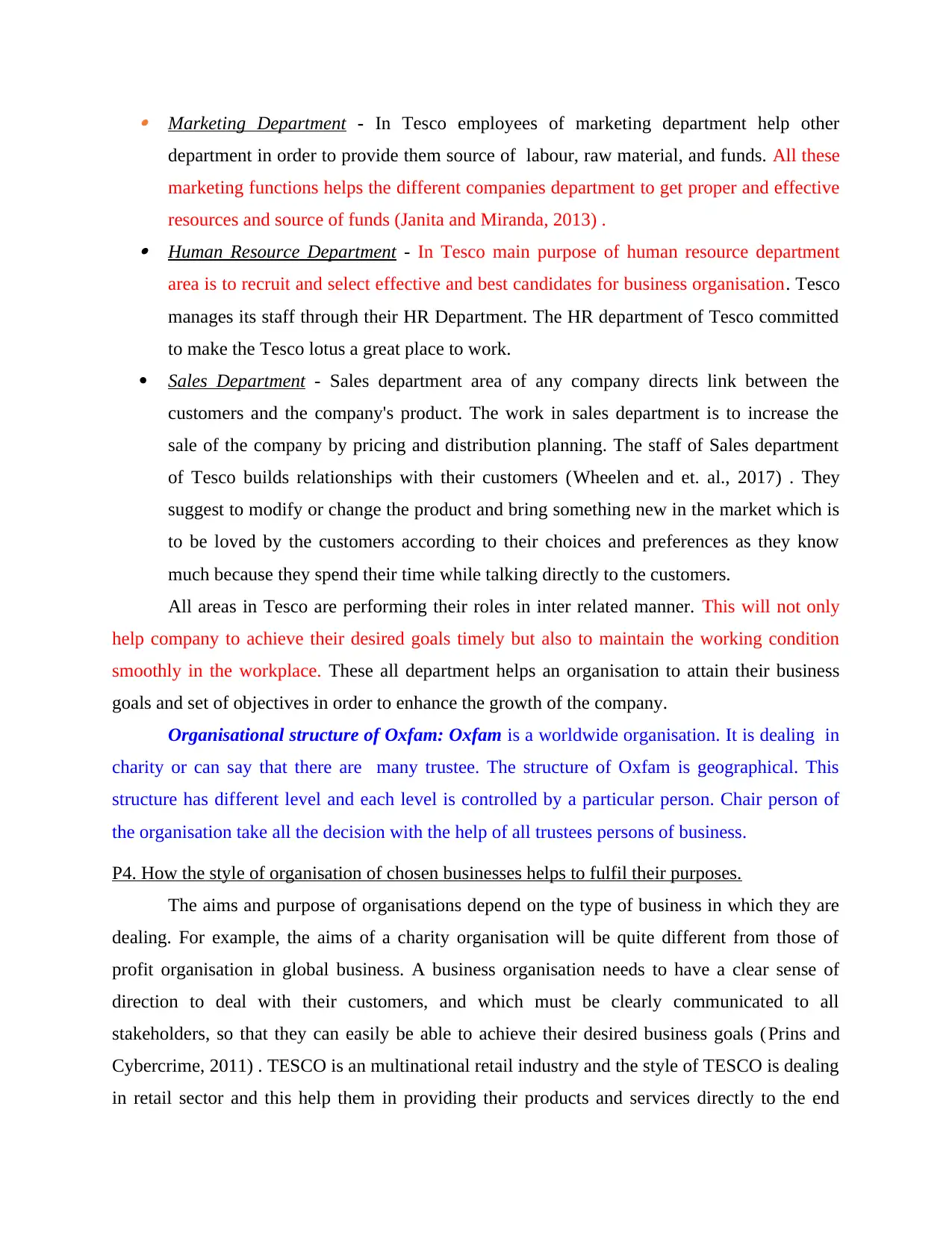
Marketing Department - In Tesco employees of marketing department help other
department in order to provide them source of labour, raw material, and funds. All these
marketing functions helps the different companies department to get proper and effective
resources and source of funds (Janita and Miranda, 2013) . Human Resource Department - In Tesco main purpose of human resource department
area is to recruit and select effective and best candidates for business organisation. Tesco
manages its staff through their HR Department. The HR department of Tesco committed
to make the Tesco lotus a great place to work.
Sales Department - Sales department area of any company directs link between the
customers and the company's product. The work in sales department is to increase the
sale of the company by pricing and distribution planning. The staff of Sales department
of Tesco builds relationships with their customers (Wheelen and et. al., 2017) . They
suggest to modify or change the product and bring something new in the market which is
to be loved by the customers according to their choices and preferences as they know
much because they spend their time while talking directly to the customers.
All areas in Tesco are performing their roles in inter related manner. This will not only
help company to achieve their desired goals timely but also to maintain the working condition
smoothly in the workplace. These all department helps an organisation to attain their business
goals and set of objectives in order to enhance the growth of the company.
Organisational structure of Oxfam: Oxfam is a worldwide organisation. It is dealing in
charity or can say that there are many trustee. The structure of Oxfam is geographical. This
structure has different level and each level is controlled by a particular person. Chair person of
the organisation take all the decision with the help of all trustees persons of business.
P4. How the style of organisation of chosen businesses helps to fulfil their purposes.
The aims and purpose of organisations depend on the type of business in which they are
dealing. For example, the aims of a charity organisation will be quite different from those of
profit organisation in global business. A business organisation needs to have a clear sense of
direction to deal with their customers, and which must be clearly communicated to all
stakeholders, so that they can easily be able to achieve their desired business goals (Prins and
Cybercrime, 2011) . TESCO is an multinational retail industry and the style of TESCO is dealing
in retail sector and this help them in providing their products and services directly to the end
department in order to provide them source of labour, raw material, and funds. All these
marketing functions helps the different companies department to get proper and effective
resources and source of funds (Janita and Miranda, 2013) . Human Resource Department - In Tesco main purpose of human resource department
area is to recruit and select effective and best candidates for business organisation. Tesco
manages its staff through their HR Department. The HR department of Tesco committed
to make the Tesco lotus a great place to work.
Sales Department - Sales department area of any company directs link between the
customers and the company's product. The work in sales department is to increase the
sale of the company by pricing and distribution planning. The staff of Sales department
of Tesco builds relationships with their customers (Wheelen and et. al., 2017) . They
suggest to modify or change the product and bring something new in the market which is
to be loved by the customers according to their choices and preferences as they know
much because they spend their time while talking directly to the customers.
All areas in Tesco are performing their roles in inter related manner. This will not only
help company to achieve their desired goals timely but also to maintain the working condition
smoothly in the workplace. These all department helps an organisation to attain their business
goals and set of objectives in order to enhance the growth of the company.
Organisational structure of Oxfam: Oxfam is a worldwide organisation. It is dealing in
charity or can say that there are many trustee. The structure of Oxfam is geographical. This
structure has different level and each level is controlled by a particular person. Chair person of
the organisation take all the decision with the help of all trustees persons of business.
P4. How the style of organisation of chosen businesses helps to fulfil their purposes.
The aims and purpose of organisations depend on the type of business in which they are
dealing. For example, the aims of a charity organisation will be quite different from those of
profit organisation in global business. A business organisation needs to have a clear sense of
direction to deal with their customers, and which must be clearly communicated to all
stakeholders, so that they can easily be able to achieve their desired business goals (Prins and
Cybercrime, 2011) . TESCO is an multinational retail industry and the style of TESCO is dealing
in retail sector and this help them in providing their products and services directly to the end

users. This all help them in identifying the change in needs of their users, so that they also can
make changes in their products and services according to their needs and requirements. This all
assist them in attaining their objectives and goals, which are setted by them. This is the aim of
the business which can then be broken down into smaller aims and objectives.
TESCO AND OXFAM HELP TO ACHIEVE THEIR PURPOISE-
main purpose of tesco is to maximise the profit of organisation and create value in customer to
their products loyalty. tesco is dealing with household products, clothing, travel insurance etc.
the purpose of Oxfam is providing facilities like medicinal facilities , providing books and many
other facilities. With all these purpose they can easily achieve their aim.
P5 The influence of two contrasting economic environment on business with in an organisation.
TESCO is a huge organisation in the world, which provide their services in different parts
of the world. They use to deal with retailing sector of grocery products, and for dealing in an
efficient manner, it is being required by them to make strategies and plans according to the
different business environments. The political factor of UK is very much stable and it provide a
very good environment for performing any business. Where as Germany is a huge economic
state of Europe and have very much strict rules and legislations related to business.
TESCO have their own rules and regulations for performing their works, but also they
have to modify their policies and rules according to the rules of the country, so that they can
achieve their target in effective manner. For example, TESCO have rule to hire employees for
their stores at specific and give a specific amount to each and every new hired person. But if the
rules of nation related to minimum wages of employees are differ than their policies, then
TESCO have to make changes in their policies of wages. Along with this, organisation have to
study the economic conditions of the nation in which they have to perform their activities of
business. This will help them in making changes to their default policies, so that they do not face
any problem and can achieve their goals and objectives.
Growth and expansion of the economy is depend on the consumption of the products and rising
in income. Both economic factor affects the company growth and Recession. If it is talk about
the economy boom it the company it leads to increase in demand of the product with increase in
price of product and it consumer are willing to buy their product which will helps the company
to make the profit maximization and wealth maximization. Where as at the time of recession the
make changes in their products and services according to their needs and requirements. This all
assist them in attaining their objectives and goals, which are setted by them. This is the aim of
the business which can then be broken down into smaller aims and objectives.
TESCO AND OXFAM HELP TO ACHIEVE THEIR PURPOISE-
main purpose of tesco is to maximise the profit of organisation and create value in customer to
their products loyalty. tesco is dealing with household products, clothing, travel insurance etc.
the purpose of Oxfam is providing facilities like medicinal facilities , providing books and many
other facilities. With all these purpose they can easily achieve their aim.
P5 The influence of two contrasting economic environment on business with in an organisation.
TESCO is a huge organisation in the world, which provide their services in different parts
of the world. They use to deal with retailing sector of grocery products, and for dealing in an
efficient manner, it is being required by them to make strategies and plans according to the
different business environments. The political factor of UK is very much stable and it provide a
very good environment for performing any business. Where as Germany is a huge economic
state of Europe and have very much strict rules and legislations related to business.
TESCO have their own rules and regulations for performing their works, but also they
have to modify their policies and rules according to the rules of the country, so that they can
achieve their target in effective manner. For example, TESCO have rule to hire employees for
their stores at specific and give a specific amount to each and every new hired person. But if the
rules of nation related to minimum wages of employees are differ than their policies, then
TESCO have to make changes in their policies of wages. Along with this, organisation have to
study the economic conditions of the nation in which they have to perform their activities of
business. This will help them in making changes to their default policies, so that they do not face
any problem and can achieve their goals and objectives.
Growth and expansion of the economy is depend on the consumption of the products and rising
in income. Both economic factor affects the company growth and Recession. If it is talk about
the economy boom it the company it leads to increase in demand of the product with increase in
price of product and it consumer are willing to buy their product which will helps the company
to make the profit maximization and wealth maximization. Where as at the time of recession the
Secure Best Marks with AI Grader
Need help grading? Try our AI Grader for instant feedback on your assignments.
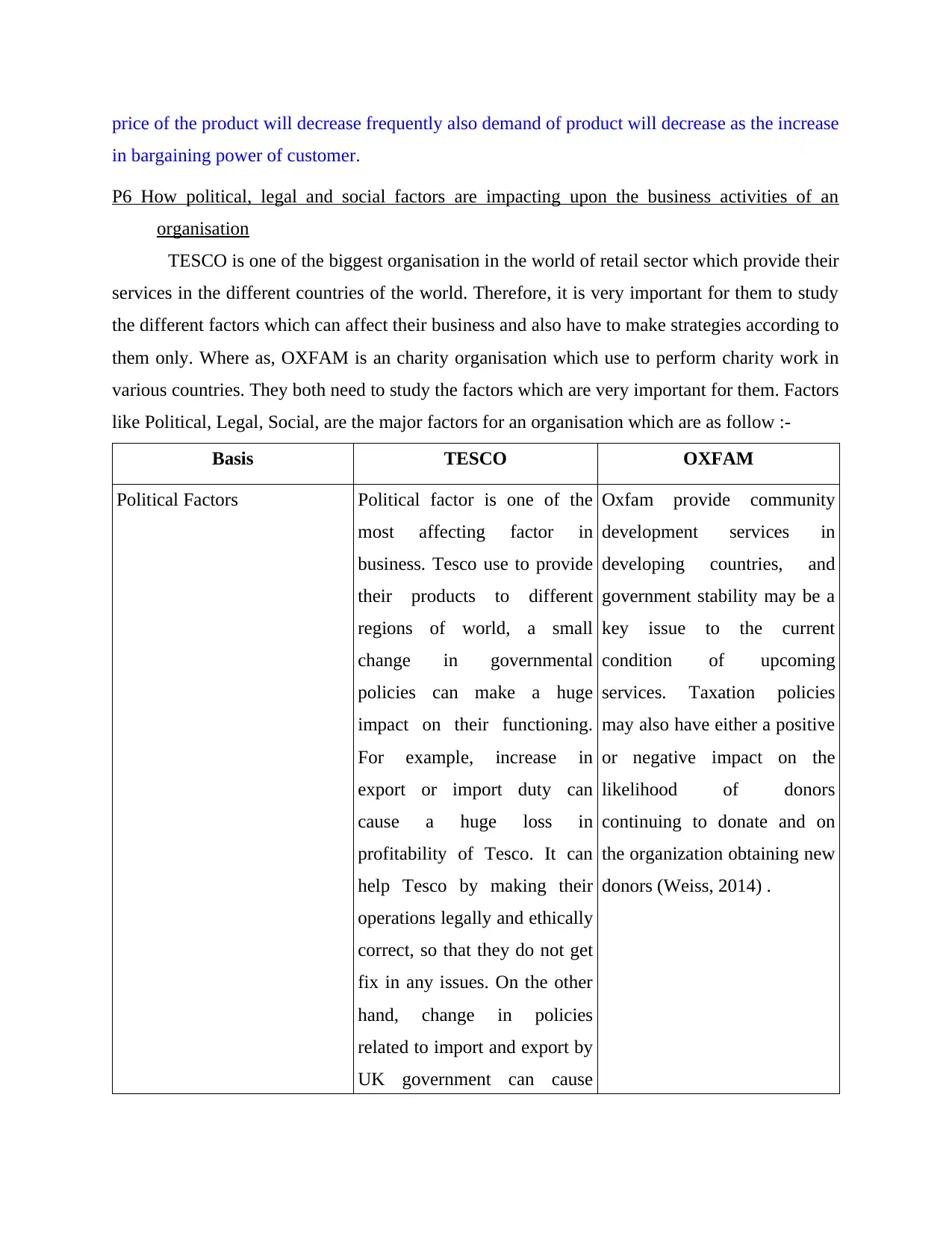
price of the product will decrease frequently also demand of product will decrease as the increase
in bargaining power of customer.
P6 How political, legal and social factors are impacting upon the business activities of an
organisation
TESCO is one of the biggest organisation in the world of retail sector which provide their
services in the different countries of the world. Therefore, it is very important for them to study
the different factors which can affect their business and also have to make strategies according to
them only. Where as, OXFAM is an charity organisation which use to perform charity work in
various countries. They both need to study the factors which are very important for them. Factors
like Political, Legal, Social, are the major factors for an organisation which are as follow :-
Basis TESCO OXFAM
Political Factors Political factor is one of the
most affecting factor in
business. Tesco use to provide
their products to different
regions of world, a small
change in governmental
policies can make a huge
impact on their functioning.
For example, increase in
export or import duty can
cause a huge loss in
profitability of Tesco. It can
help Tesco by making their
operations legally and ethically
correct, so that they do not get
fix in any issues. On the other
hand, change in policies
related to import and export by
UK government can cause
Oxfam provide community
development services in
developing countries, and
government stability may be a
key issue to the current
condition of upcoming
services. Taxation policies
may also have either a positive
or negative impact on the
likelihood of donors
continuing to donate and on
the organization obtaining new
donors (Weiss, 2014) .
in bargaining power of customer.
P6 How political, legal and social factors are impacting upon the business activities of an
organisation
TESCO is one of the biggest organisation in the world of retail sector which provide their
services in the different countries of the world. Therefore, it is very important for them to study
the different factors which can affect their business and also have to make strategies according to
them only. Where as, OXFAM is an charity organisation which use to perform charity work in
various countries. They both need to study the factors which are very important for them. Factors
like Political, Legal, Social, are the major factors for an organisation which are as follow :-
Basis TESCO OXFAM
Political Factors Political factor is one of the
most affecting factor in
business. Tesco use to provide
their products to different
regions of world, a small
change in governmental
policies can make a huge
impact on their functioning.
For example, increase in
export or import duty can
cause a huge loss in
profitability of Tesco. It can
help Tesco by making their
operations legally and ethically
correct, so that they do not get
fix in any issues. On the other
hand, change in policies
related to import and export by
UK government can cause
Oxfam provide community
development services in
developing countries, and
government stability may be a
key issue to the current
condition of upcoming
services. Taxation policies
may also have either a positive
or negative impact on the
likelihood of donors
continuing to donate and on
the organization obtaining new
donors (Weiss, 2014) .
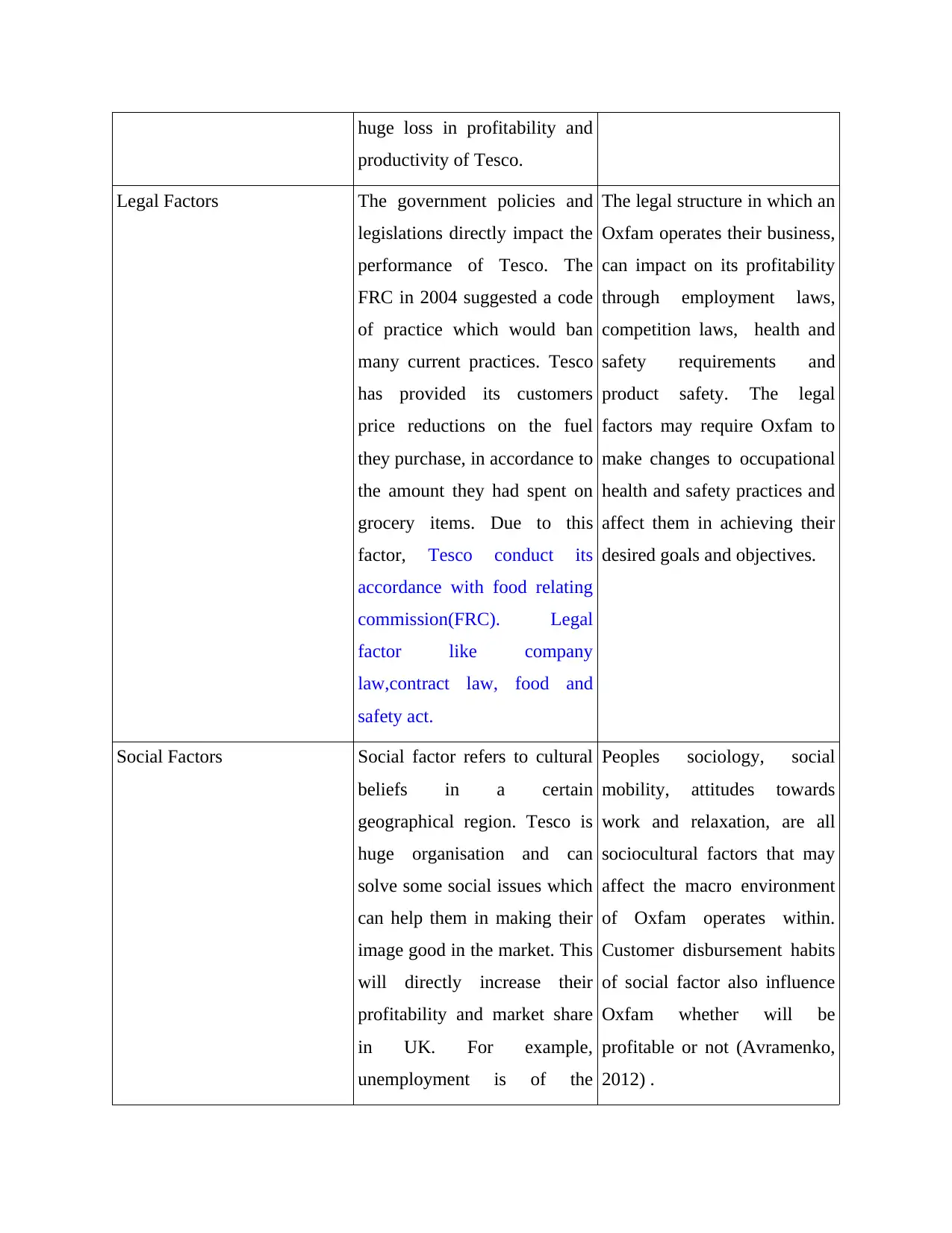
huge loss in profitability and
productivity of Tesco.
Legal Factors The government policies and
legislations directly impact the
performance of Tesco. The
FRC in 2004 suggested a code
of practice which would ban
many current practices. Tesco
has provided its customers
price reductions on the fuel
they purchase, in accordance to
the amount they had spent on
grocery items. Due to this
factor, Tesco conduct its
accordance with food relating
commission(FRC). Legal
factor like company
law,contract law, food and
safety act.
The legal structure in which an
Oxfam operates their business,
can impact on its profitability
through employment laws,
competition laws, health and
safety requirements and
product safety. The legal
factors may require Oxfam to
make changes to occupational
health and safety practices and
affect them in achieving their
desired goals and objectives.
Social Factors Social factor refers to cultural
beliefs in a certain
geographical region. Tesco is
huge organisation and can
solve some social issues which
can help them in making their
image good in the market. This
will directly increase their
profitability and market share
in UK. For example,
unemployment is of the
Peoples sociology, social
mobility, attitudes towards
work and relaxation, are all
sociocultural factors that may
affect the macro environment
of Oxfam operates within.
Customer disbursement habits
of social factor also influence
Oxfam whether will be
profitable or not (Avramenko,
2012) .
productivity of Tesco.
Legal Factors The government policies and
legislations directly impact the
performance of Tesco. The
FRC in 2004 suggested a code
of practice which would ban
many current practices. Tesco
has provided its customers
price reductions on the fuel
they purchase, in accordance to
the amount they had spent on
grocery items. Due to this
factor, Tesco conduct its
accordance with food relating
commission(FRC). Legal
factor like company
law,contract law, food and
safety act.
The legal structure in which an
Oxfam operates their business,
can impact on its profitability
through employment laws,
competition laws, health and
safety requirements and
product safety. The legal
factors may require Oxfam to
make changes to occupational
health and safety practices and
affect them in achieving their
desired goals and objectives.
Social Factors Social factor refers to cultural
beliefs in a certain
geographical region. Tesco is
huge organisation and can
solve some social issues which
can help them in making their
image good in the market. This
will directly increase their
profitability and market share
in UK. For example,
unemployment is of the
Peoples sociology, social
mobility, attitudes towards
work and relaxation, are all
sociocultural factors that may
affect the macro environment
of Oxfam operates within.
Customer disbursement habits
of social factor also influence
Oxfam whether will be
profitable or not (Avramenko,
2012) .
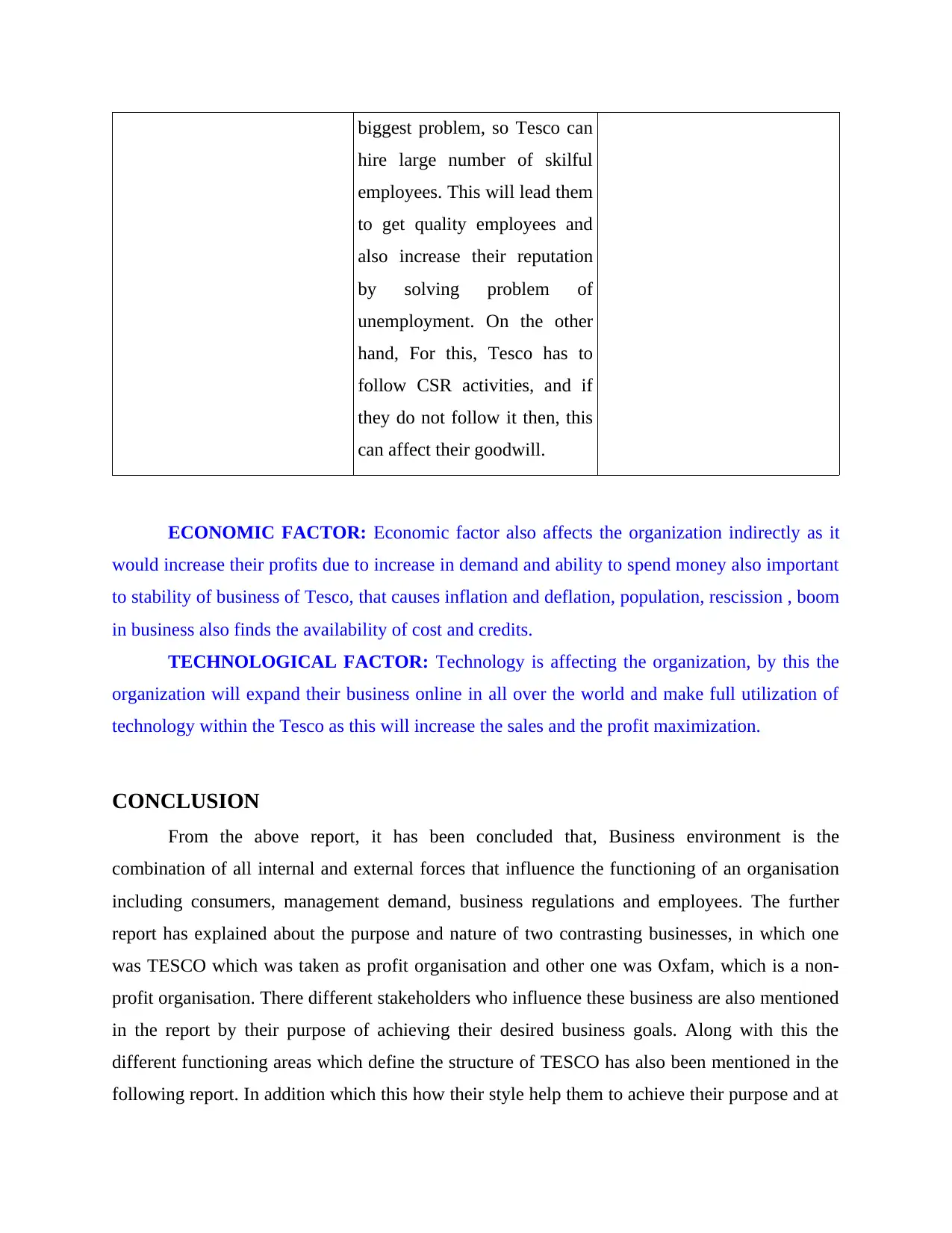
biggest problem, so Tesco can
hire large number of skilful
employees. This will lead them
to get quality employees and
also increase their reputation
by solving problem of
unemployment. On the other
hand, For this, Tesco has to
follow CSR activities, and if
they do not follow it then, this
can affect their goodwill.
ECONOMIC FACTOR: Economic factor also affects the organization indirectly as it
would increase their profits due to increase in demand and ability to spend money also important
to stability of business of Tesco, that causes inflation and deflation, population, rescission , boom
in business also finds the availability of cost and credits.
TECHNOLOGICAL FACTOR: Technology is affecting the organization, by this the
organization will expand their business online in all over the world and make full utilization of
technology within the Tesco as this will increase the sales and the profit maximization.
CONCLUSION
From the above report, it has been concluded that, Business environment is the
combination of all internal and external forces that influence the functioning of an organisation
including consumers, management demand, business regulations and employees. The further
report has explained about the purpose and nature of two contrasting businesses, in which one
was TESCO which was taken as profit organisation and other one was Oxfam, which is a non-
profit organisation. There different stakeholders who influence these business are also mentioned
in the report by their purpose of achieving their desired business goals. Along with this the
different functioning areas which define the structure of TESCO has also been mentioned in the
following report. In addition which this how their style help them to achieve their purpose and at
hire large number of skilful
employees. This will lead them
to get quality employees and
also increase their reputation
by solving problem of
unemployment. On the other
hand, For this, Tesco has to
follow CSR activities, and if
they do not follow it then, this
can affect their goodwill.
ECONOMIC FACTOR: Economic factor also affects the organization indirectly as it
would increase their profits due to increase in demand and ability to spend money also important
to stability of business of Tesco, that causes inflation and deflation, population, rescission , boom
in business also finds the availability of cost and credits.
TECHNOLOGICAL FACTOR: Technology is affecting the organization, by this the
organization will expand their business online in all over the world and make full utilization of
technology within the Tesco as this will increase the sales and the profit maximization.
CONCLUSION
From the above report, it has been concluded that, Business environment is the
combination of all internal and external forces that influence the functioning of an organisation
including consumers, management demand, business regulations and employees. The further
report has explained about the purpose and nature of two contrasting businesses, in which one
was TESCO which was taken as profit organisation and other one was Oxfam, which is a non-
profit organisation. There different stakeholders who influence these business are also mentioned
in the report by their purpose of achieving their desired business goals. Along with this the
different functioning areas which define the structure of TESCO has also been mentioned in the
following report. In addition which this how their style help them to achieve their purpose and at
Paraphrase This Document
Need a fresh take? Get an instant paraphrase of this document with our AI Paraphraser
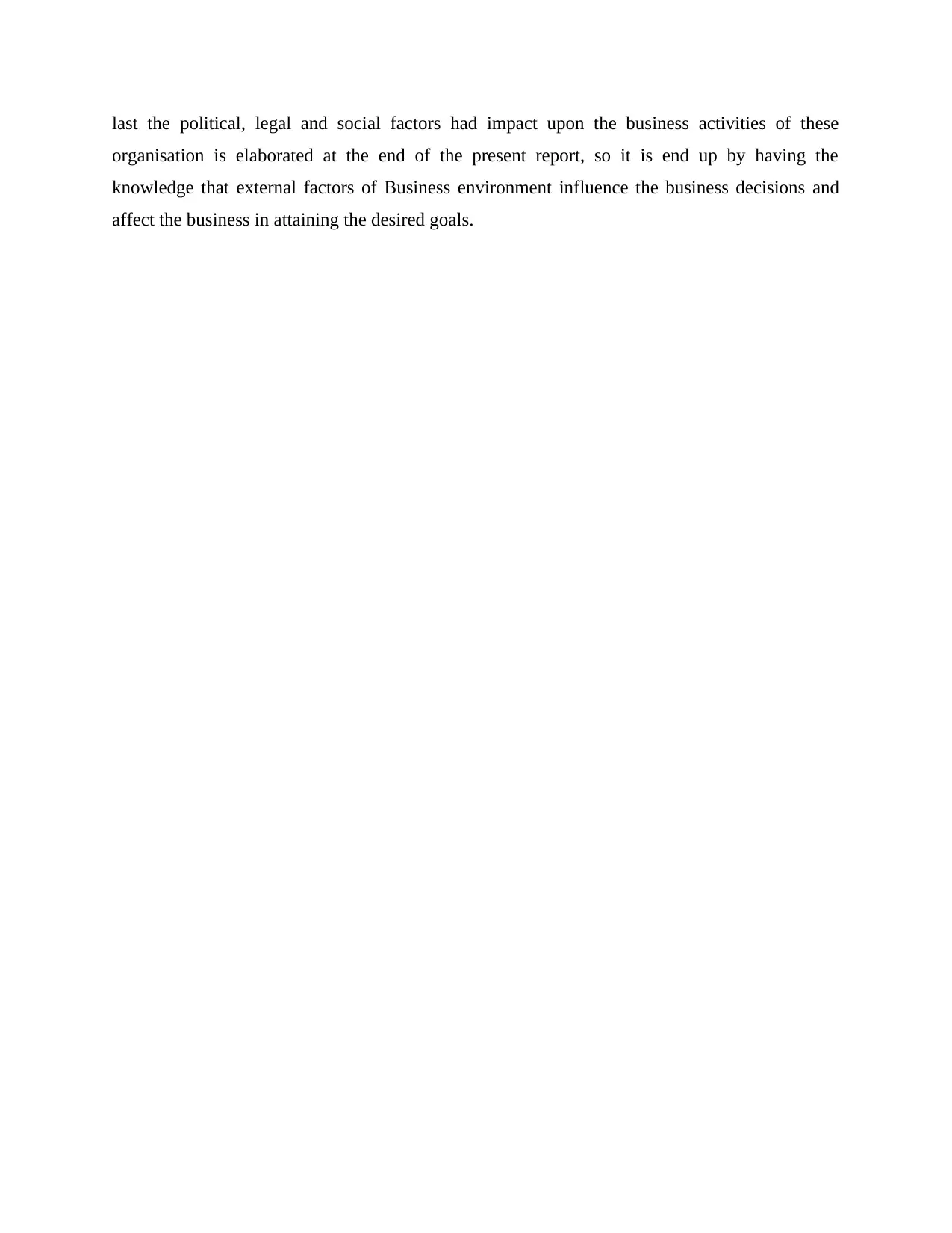
last the political, legal and social factors had impact upon the business activities of these
organisation is elaborated at the end of the present report, so it is end up by having the
knowledge that external factors of Business environment influence the business decisions and
affect the business in attaining the desired goals.
organisation is elaborated at the end of the present report, so it is end up by having the
knowledge that external factors of Business environment influence the business decisions and
affect the business in attaining the desired goals.
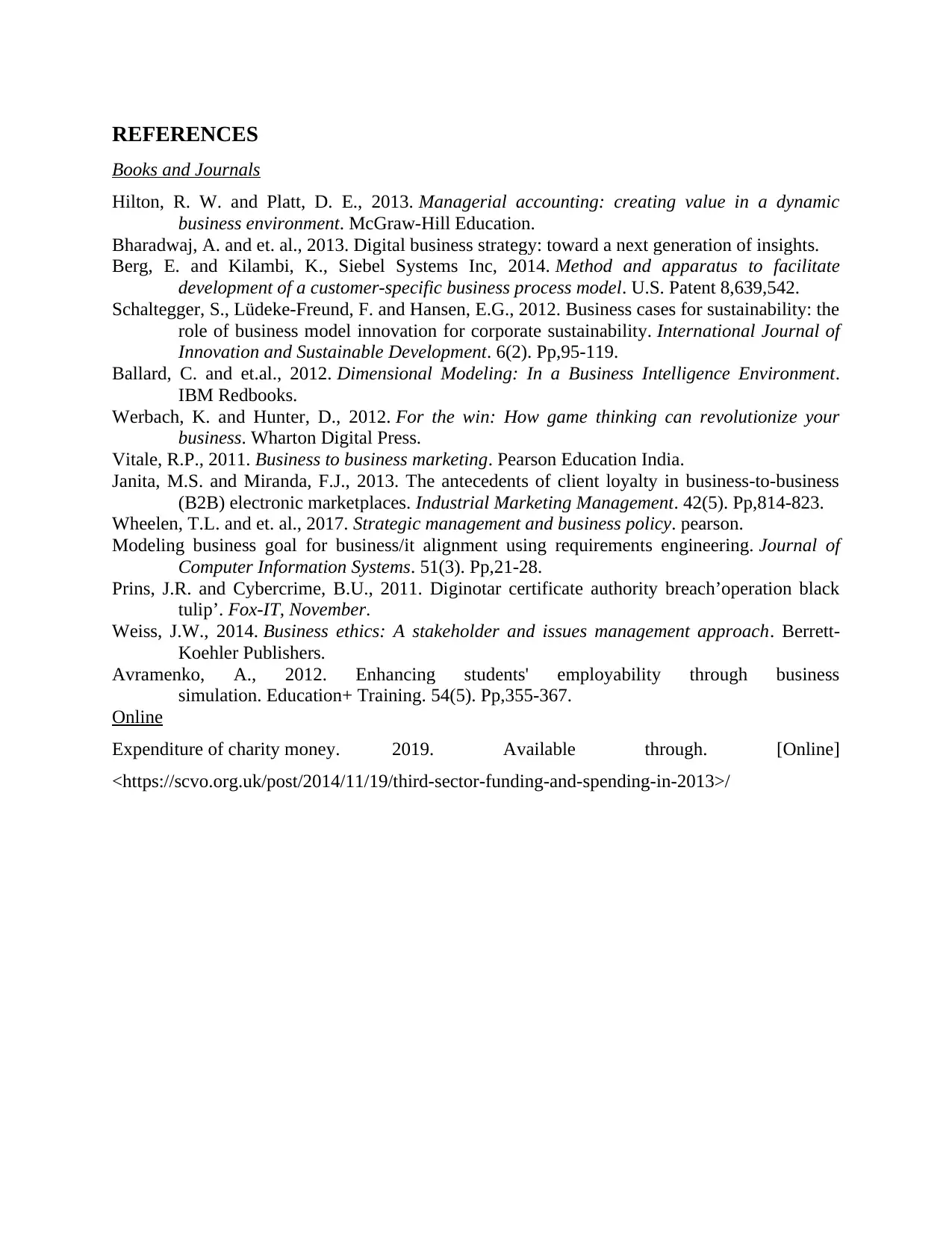
REFERENCES
Books and Journals
Hilton, R. W. and Platt, D. E., 2013. Managerial accounting: creating value in a dynamic
business environment. McGraw-Hill Education.
Bharadwaj, A. and et. al., 2013. Digital business strategy: toward a next generation of insights.
Berg, E. and Kilambi, K., Siebel Systems Inc, 2014. Method and apparatus to facilitate
development of a customer-specific business process model. U.S. Patent 8,639,542.
Schaltegger, S., Lüdeke-Freund, F. and Hansen, E.G., 2012. Business cases for sustainability: the
role of business model innovation for corporate sustainability. International Journal of
Innovation and Sustainable Development. 6(2). Pp,95-119.
Ballard, C. and et.al., 2012. Dimensional Modeling: In a Business Intelligence Environment.
IBM Redbooks.
Werbach, K. and Hunter, D., 2012. For the win: How game thinking can revolutionize your
business. Wharton Digital Press.
Vitale, R.P., 2011. Business to business marketing. Pearson Education India.
Janita, M.S. and Miranda, F.J., 2013. The antecedents of client loyalty in business-to-business
(B2B) electronic marketplaces. Industrial Marketing Management. 42(5). Pp,814-823.
Wheelen, T.L. and et. al., 2017. Strategic management and business policy. pearson.
Modeling business goal for business/it alignment using requirements engineering. Journal of
Computer Information Systems. 51(3). Pp,21-28.
Prins, J.R. and Cybercrime, B.U., 2011. Diginotar certificate authority breach’operation black
tulip’. Fox-IT, November.
Weiss, J.W., 2014. Business ethics: A stakeholder and issues management approach. Berrett-
Koehler Publishers.
Avramenko, A., 2012. Enhancing students' employability through business
simulation. Education+ Training. 54(5). Pp,355-367.
Online
Expenditure of charity money. 2019. Available through. [Online]
<https://scvo.org.uk/post/2014/11/19/third-sector-funding-and-spending-in-2013>/
Books and Journals
Hilton, R. W. and Platt, D. E., 2013. Managerial accounting: creating value in a dynamic
business environment. McGraw-Hill Education.
Bharadwaj, A. and et. al., 2013. Digital business strategy: toward a next generation of insights.
Berg, E. and Kilambi, K., Siebel Systems Inc, 2014. Method and apparatus to facilitate
development of a customer-specific business process model. U.S. Patent 8,639,542.
Schaltegger, S., Lüdeke-Freund, F. and Hansen, E.G., 2012. Business cases for sustainability: the
role of business model innovation for corporate sustainability. International Journal of
Innovation and Sustainable Development. 6(2). Pp,95-119.
Ballard, C. and et.al., 2012. Dimensional Modeling: In a Business Intelligence Environment.
IBM Redbooks.
Werbach, K. and Hunter, D., 2012. For the win: How game thinking can revolutionize your
business. Wharton Digital Press.
Vitale, R.P., 2011. Business to business marketing. Pearson Education India.
Janita, M.S. and Miranda, F.J., 2013. The antecedents of client loyalty in business-to-business
(B2B) electronic marketplaces. Industrial Marketing Management. 42(5). Pp,814-823.
Wheelen, T.L. and et. al., 2017. Strategic management and business policy. pearson.
Modeling business goal for business/it alignment using requirements engineering. Journal of
Computer Information Systems. 51(3). Pp,21-28.
Prins, J.R. and Cybercrime, B.U., 2011. Diginotar certificate authority breach’operation black
tulip’. Fox-IT, November.
Weiss, J.W., 2014. Business ethics: A stakeholder and issues management approach. Berrett-
Koehler Publishers.
Avramenko, A., 2012. Enhancing students' employability through business
simulation. Education+ Training. 54(5). Pp,355-367.
Online
Expenditure of charity money. 2019. Available through. [Online]
<https://scvo.org.uk/post/2014/11/19/third-sector-funding-and-spending-in-2013>/
1 out of 15
Related Documents
Your All-in-One AI-Powered Toolkit for Academic Success.
+13062052269
info@desklib.com
Available 24*7 on WhatsApp / Email
![[object Object]](/_next/static/media/star-bottom.7253800d.svg)
Unlock your academic potential
© 2024 | Zucol Services PVT LTD | All rights reserved.





